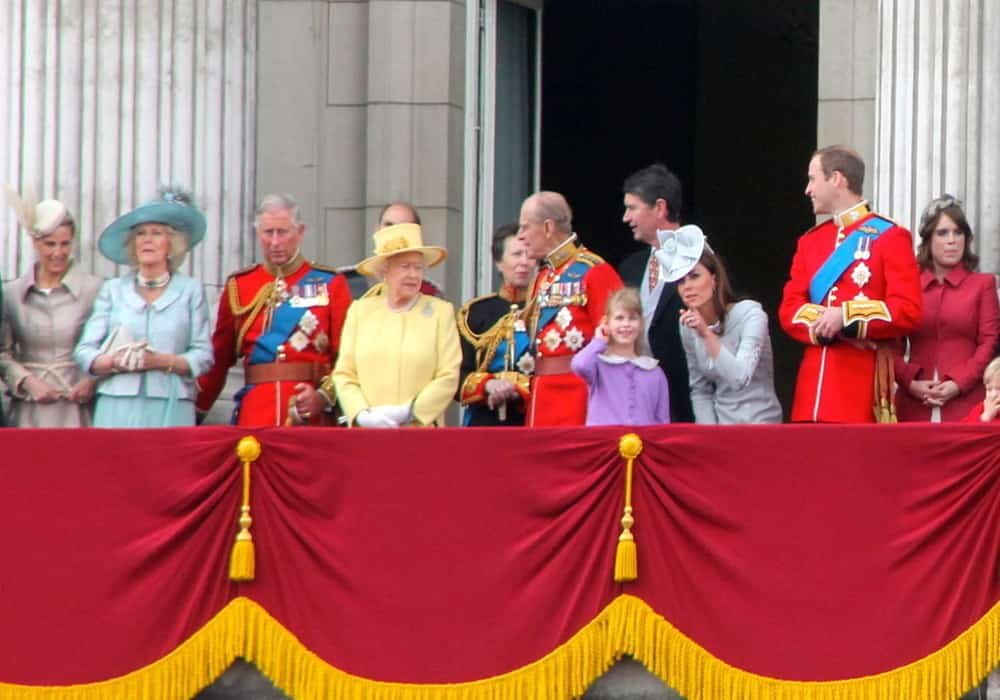British Royal Family
The British royal family consists of the Queen or King of the United Kingdom of Great Britain and Northern Ireland and their closest relatives.
The head of the British royal family reigns as monarch over the United Kingdom and other Commonwealth territories, such as Canada and Australia.
The British Royal Family includes Queen Elizabeth II, her husband Prince Philip, Duke of Edinburgh, their children and grandchildren. More broadly, the royal family also includes the cousins of Queen Elizabeth, their own children and grandchildren.
Members of the British Royal Family
Queen Elizabeth II (RIP: September 8, 2022)
Prince Philip, Duke of Edinburgh (RIP: April 9, 2021)
The Queen’s children and their husbands/wifes:
Prince Charles, Prince of Wales and Duchess of Cornwall (now King Charles III)
Princess Anne, Princess Royal and Sir Timothy Laurence
Prince Andrew, Duke of York
Prince Edward, Earl of Wessex and Sophie of Wessex
The Queen’s grandchildren and their husbands/wifes:
Prince William, Duke of Cambridge and Kate Middleton
Prince Harry, Duke of Sussex and Meghan Markle
Peter Phillips and Autumn Kelly
Zara Phillips and Mark Tindall
Princess Beatrice of York and Edoardo Mapelli Mozzi
Princess Eugenie of York and Jack Brooksbank
Lady Louise Mountbatten-Windsor
James Mountbatten-Windsor, Viscount Severn
Former members of the British royal family
Members of the royal family who have died in recent years:
- Princess Alice, Duchess of Gloucester (daughter-in-law of King George V)
- Queen Elisabeth , “Queen Mum”, the queen mother (widow of King George VI)
- Princess Margaret, Countess of Snowdon , sister of the Queen (daughter of King George VI)
- Diana, Princess of Wales , daughter-in-law of the Queen (first wife of the Prince of Wales; no longer a member of the official royal family since her divorce in 1996)
Divorced spouses of members of the royal family (not members of the official royal family):
- Sarah, Duchess of York (former wife of the Duke of York)
- Mark Phillips (ex-husband of the Princess Royal)
- Antony Armstrong-Jones, 1st Earl of Snowdon (ex-husband of Princess Margaret), died in 2017.
Membership criteria
Although there is no strict legal definition of who is and who is not a member of the royal family, it usually includes those people who have either the title “His Majesty” or “Her Majesty” ( His Majesty or Her Majesty , HM) or else the title of “His Royal Highness” or “Her Royal Highness” ( His Royal Highness and Her Royal Highness , HRH wear). According to these conditions, the following people belong to the royal family :
- the British monarch
- the Royal Consort
- the widowed spouses of previous monarchs
- the children of a monarch
- the spouses and widowed spouses of the sons of a monarch
- the grandchildren of a monarch in the male line (and their spouses and widowed spouses)
- all children of the eldest son of the ” Prince of Wales “
Until 1917, all great-grandchildren in the male line belonged to the royal family. Since 1996 members of the royal family by marriage have been losing their status if they divorce or remarry after their spouse’s death.
Descendants of Queen Elizabeth II
- The Prince of Wales and the Duchess of Cornwall (Prince Charles of Wales, the Queen’s eldest son, and his wife Camilla Parker Bowles [née Shand])
- The Duke and Duchess of Cambridge (Prince William, eldest son of the Prince of Wales, and his wife Catherine Middleton)
- Prince George of Cambridge (eldest son of the Duke of Cambridge)
- Princess Charlotte of Cambridge (daughter of the Duke of Cambridge)
- Prince Louis of Cambridge (younger son of the Duke of Cambridge)
- The Duke and Duchess of Sussex (Prince Henry, youngest son of the Prince of Wales, and his wife Meghan Markle)
- The Duke and Duchess of Cambridge (Prince William, eldest son of the Prince of Wales, and his wife Catherine Middleton)
- The Princess Royal (Princess Anne, daughter of the Queen)
- The Duke of York (Prince Andrew, the Queen’s youngest son)
- Princess Beatrice of York (eldest daughter of the Duke of York)
- Princess Eugenie of York (younger daughter of the Duke of York)
- The Earl and Countess of Wessex (Prince Edward, the Queen’s youngest son, and his wife Sophie Rhys-Jones)
- Lady Louise Windsor (daughter of the Earl of Wessex)
- Viscount Severn (James Mountbatten-Windsor, son of the Earl of Wessex)
Descendants of George V
- The Duke and Duchess of Gloucester (Richard of Gloucester, cousin of the queen, and his wife Birgitte van Deurs)
- The Duke and Duchess of Kent (Edward of Kent, cousin of the Queen, and his wife Katharine Worsley)
- Prince and Princess Michael of Kent (cousin of the Queen, and his wife Marie-Christine von Reibnitz)
- Princess Alexandra of Kent (cousin of the Queen)
7 things to know about the British royal family
Anyone who has lived in the UK knows that the Royal Family holds a special place in British history, let alone that it holds in modern culture. You may have already taken a photo outside Buckingham Palace hoping to catch a glimpse of the Queen or just watched The Crown on Netflix and thought you’d be perfect in the midst of this family drama. Either way, the royals are a part of everyday British life and are doomed to stay there.
If you’re planning to stay in the UK for a while and want to learn all about The Queen and her court, here’s what you need to know.
1. The population adores them (the vast majority)
If you travel to the four corners of Great Britain, you will certainly find people who are not very fond of the monarchy – however, they are largely contradicted by surveys carried out across the UK. Apparently, seven in ten Britons appreciate the presence of the royal family. Perhaps it is a good thing to have an intermediary authority between the people and the government? Or maybe, as I do, it’s because the Queen reminds her subjects of their own grandmother – and I will never let anyone insult my grandmother. NO ONE.
2. They own a host of residences
“Why does the Queen never come out of Buckingham Palace to greet the crowd?” “I often hear people cry in disappointment. In truth, it’s because she’s never really there. All members of the Royal Family and their extended family have many residences, but the Queen and her husband, the Duke of Edinburgh, have no less than eight, which they take turns to occupy according to their need. to host royal events or whatever they want: Buckingham Palace, Windsor Castle, Holyrood Palace, Hillsborough Castle, Sandringham Manor, Balmoral Castle, Craigowan Lodge and Delnadamph Lodge. Half of these mansions are in Scotland, about 600 km from London, which is understandable if one thinks “how fed up the Queen must have been with these tourists who constantly flock to her palace. ”
3. They are not “100% British”
The Queen’s family was originally German and, through the Duke of Edinburgh, the royals are of Danish and Greek descent. Now that Prince Harry has married American actress Meghan Markle, the future descendants of the family will also have African-American origins. In many ways, the Royal Family is a metaphor for the eclectic nature of the British people and the diversity of their genetic backgrounds.
4. They still hold the supreme power (… well almost)
Royal authority is not what it used to be – whereas in the past the reigning monarch was the only one to make decisions as important as the entry into war of the country or the laws to be adopted, nowadays, great part of this power has been vested in the government, in charge of deciding on behalf of the Queen. However, there is a loophole to get around this and make some decisions outside of parliament (where elected officials pass laws on behalf of the people) and some prime ministers have used this to their advantage in the past, thus passing certain motions without asking. the opinion of parliament. Sneaky ministers.
5. Only members of the royal family can eat swan
There are some odd old-time rules in any country with a royal family that no longer make sense in the modern world. For example, it is illegal to capture whales or dolphins within 3 miles of the UK coastline, and any dead representative of these two species that naturally ends up in territorial waters de facto belongs to the Queen. She also automatically owns all the swans that don’t speak (possibly one of the strangest laws we’ve ever heard). Stranger still, only members of the royal family are allowed to eat swan. This means that you cannot capture or kill a swan and in fact explains the strange respect or fear that the British have for these towering white birds. For the record, also know that a swan can break your arm with just its wings – so, you better not joke this animal, even if it was allowed.
6. The queen is both Elizabeth I and Elizabeth II
This point sounds complicated, but it’s actually quite simple. Queen Elizabeth is the second of the name in England, which officially makes her Queen Elizabeth II. However, in Scotland she is only the first of the name, since Queen Elizabeth I never reigned in this country, thus the current Queen is both Elizabeth I and Elizabeth II at the same time. What a luck!
7. Prince Philip is not a king
Although Elizabeth II is Queen, her husband, Prince Philip, Duke of Edinburgh, is not King and this is perhaps one of the most surprising facts about the Royal Family. In fact, a woman becomes queen when she marries a prince and the prince becomes king, but the same rule does not apply to a man when he marries a princess who then becomes queen. Prince Philip received the title upon his marriage to Elizabeth (although he had to give up his Greek royal title in order to marry it), but he was never given the right to become king. An interesting rule, but one that may need to evolve in the future, if royal law is to continue following the progressive line recently adopted by members of his family.
Longest Reigning World Monarchs Ever (Emperor, King, Queen, Prince)
Read also: Nobility and Greeting Vocabulary for Nobles or Aristocracy
Photo source: Wikimedia Commons



